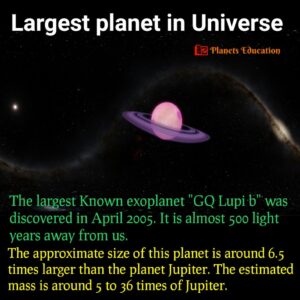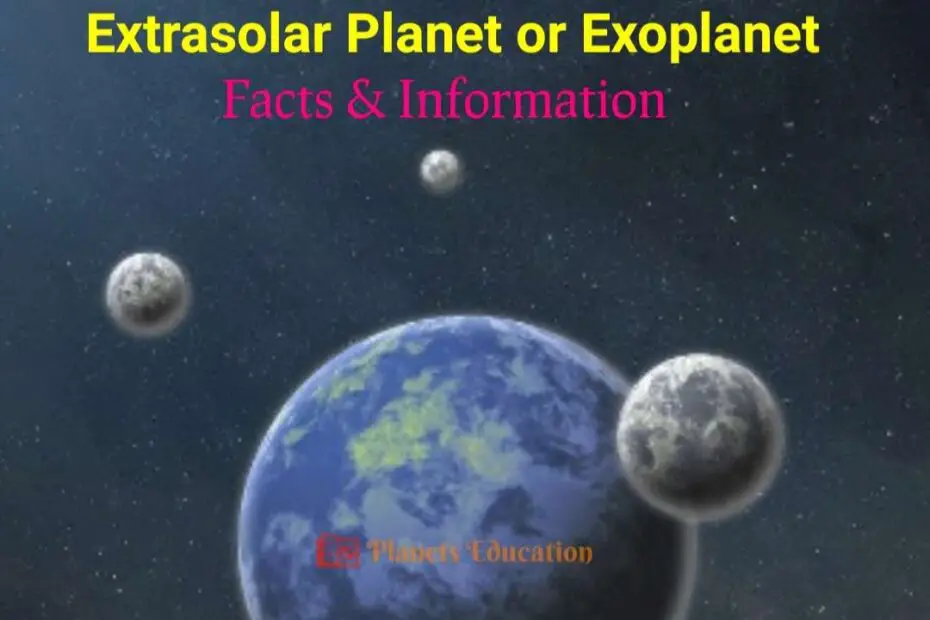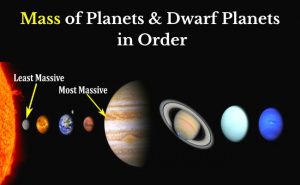Exoplanets are the planets that exist outside of our solar system and are also known as Extrasolar Planets. We can say all planets of the Universe are an exoplanet except our 8 solar system planets.
Though there is no confirmation of any extrasolar planet outside of the milky-way galaxy. But according to scientists, extragalactic planets may exist. Even the first confirmed detection of an exoplanet was done 28 years ago, in 1992.
After that many planets have been detected outside of our solar system. Some of them are much smaller than our Earth and some are super bigger than Jupiter. According to a hypothesis of astronomers, there could be around 11 billion habitable earth-sized exoplanets only in our milky way.
- Must Read:- Kepler-186f: 1st Earth-Like Habitable Planet
As we know, 8 planets are there in our solar system, orbiting our sun (a star). By an estimation, more than 100 billion stars are available only in our galaxy milky way. So according to this fact, we can just imagine how many extrasolar planets would be there only in one galaxy. Of course, many more times of present stars. What if we include the whole universe?
- Also read about:- 8 Solar System Planets
Facts about Exoplanets
Here we have mentioned some special facts about extrasolar planets with proper information, such as the largest exoplanet, exoplanet similar to earth, least massive and most massive exoplanet, habitable and nearest extrasolar planet to earth, etc.
⇒ 4000 and more confirmed exoplanets
If you are a space facts lover, you must have thought about the planets outside of our solar system. Do you know “when was the first exoplanet discovered”? The first confirmed exoplanets were detected in 1992. Before 1992 human was not much more capable to discover outside worlds.
Well, now we have started discovering about them, mostly to search for habitable extrasolar planets. So here’s a question that arises now how many exoplanets have we found so far?
More than 4200 exoplanets have been searched and confirmed by scientists so far. Whereas, almost 3500 worlds have been searched, and waiting for more observations to be confirmed as an extrasolar planets.
⇒ Number of Earth-like exoplanets
If you are thinking life exists only on our earth, then you may be wrong. Astronomers have estimated that 20% of Sun-like stars in the milky way galaxy have at least 1 Earth-size exoplanet in the habitable zone.
If we consider the sun-like and red dwarf stars of our milky way galaxy. Then these stars may have approximately 40 billion earth-like extrasolar planets.
- Read about:- Galaxy Questions and Answers
⇒ Least massive exoplanet
WD 1145+017 b is an extrasolar planet that lies outside of our solar system in the constellation of Virgo. It is confirmed as a known least massive planet in the universe with a mass of almost 0.0006 times the earth.
This world was discovered in October 2015 by the Kepler Space Telescope of NASA. It orbits a star known as WD 1145+017 and locates almost 570 light-years away from us. It’s a rocky planet and the star is a white dwarf type.
Before 2015, PSR B1257+12b was the least massive extrasolar planet. It is also located in the constellation of Virgo. The distance of this planet is around 2300 light-years away from us. It is known as Draugr and has a mass of around 2 times the moon.
⇒ Most massive extrasolar planet
The name of the most massive planet is HR2562b, orbiting a star known as HR2562. It is listed as the most massive extrasolar planet in NASA’s Exoplanet Catalog. This planet has a mass of approximately 30 times of Jupiter.
It is so massive to be considered as a brown dwarf star instead of a planet. Brown dwarf stars have a mass range between 13 to 80 times Jupiter. Though there is no proper mass boundary between a planet and a brown dwarf.
- Also Read About:– Types of Stars: Brown Dwarf
⇒ Largest exoplanet discovered
The largest exoplanet GQ Lupi b was discovered in April 2005. It orbits a star GQ Lupi, located in the constellation of Lupus almost 500 light-years away from us. According to scientists, it can be either a small brown dwarf or a large Jupiter-like exoplanet.

The approximate size of this planet is around 6.5 times larger than the planet Jupiter. No exact mass has been determined but scientists have estimated that it could range from 5 to 36 times more massive than Jupiter. Because of its mass, it could also be classified as a small brown dwarf.
⇒ Nearest exoplanet to earth
The nearest extrasolar planet from us is “Proxima Centauri b” and it orbits a red dwarf star Proxima Centauri. This closest world exists only 4.2 light-years away from us in the constellation of Centaurus.
Proxima Centauri b was discovered in August 2016. The exact mass of this planet is not known but scientists believe that it could be very near to earth’s mass, like 1 to 2 times earth’s mass. And it exists in the habitable zone of its star Proxima Centauri.
⇒ Most similar exoplanet to earth
A recently discovered planet “Teegarden b” is the most similar Earth-like extrasolar object. The earth-similarity-index (ESI) score of this planet is 0.95 and this is the highest ESI score of any celestial known object.
This planet was discovered in June 2019. It locates 12 light-years away from us. Teegarden b orbits a red dwarf star ‘Teegarden’ and the planet exist in its habitable zone. It is also a rocky planet and the mass is almost similar to earth’s mass. According to scientists, this exoplanet may have an ocean of water on the surface.
Teegarden b exoplanet may have a habitable surface temperature of 0 to 50°C. The temperature reaching from its host star makes it a most earth likely planet for existing of life.
⇒ First discovered Extrasolar planet
The Discovery of an extrasolar planet brings interest to the search for extraterrestrial life in our universe. Scientists, astronomers, and philosophers suspected its existence. In many science fiction stories, writers have predicted the existence of outside planets.
It’s a fact that there is no first discovered exoplanet, though there are two “first discovered extrasolar planets”. On 22 January 1992, Polish astronomer Aleksander Wolszczan claimed to discover two extrasolar planets PSR B1257+12c and PSR B1257+12d. PSR B1257+12c is known as Poltergeist, whereas PSR B1257+12d is named Phobetor.
PSR B1257+12b was discovered in 1994 and known as Draugr. These three exoplanets are located in the constellation of Virgo (2300 light-years away from our sun) and are known as three pulsar planets for orbiting a pulsar “PSR B1257+12”.
- Also Read:- What is a rogue planet
Types of extrasolar planets
The extrasolar planets are classified into many categories according to their size and look alike. Following are the main types of exoplanets described by astronomers:
- Rocky-Planets
- Earth-Like
- Super-Earth
- Ocean-Planets
- Mini-Neptune
- Gas-Dwarfs
- Neptune-Like
- Gas-Giants
- Super-Jupiter
⇒ The rocky planets and Earth-like worlds are those types of exoplanets that are mostly made of silicate rocks or metals. Earth-like exoplanets can have the same physical properties as our earth. Planets smaller than earth come in the category of rocky planets.
⇒ Super-Earth worlds are larger and more massive rocky worlds than our earth. But these types of extrasolar planets are smaller than Neptune-like and giant planets. The mass of the super-earth can range from 1 to 10 earth masses.
⇒ Ocean planets are also a type of rocky planet. But ocean exoplanets contain water on their surface. These exoplanets contain enough water to cover the entire surface of the planet with oceans.
⇒ Mini-Neptunes have less mass compared to our planet Neptune. These planets are ice giants and can also contain liquid water, ammonia, or both. Sometimes mini-Neptunes represent gas-dwarf exoplanets as gas dwarfs are also less massive than Neptunes. Gas dwarf contains gases surface, whereas their core is rocky. These types of extrasolar planets have a mass range of 10 to 15 times the earth.
⇒ Neptune-like exoplanets are ice giant planets. They are similar to the planet Uranus and Neptune. The mass range can be up to almost 30 times the earth.
⇒ Gas-giants are large planets and made of gases like hydrogen and helium. The size and mass range of these planets belong to the size of Jupiter or Saturn.
⇒ Super-Jupiter comes in the category of largest exoplanets. These extrasolar worlds are more massive and larger than planet Jupiter. Super Jupiter can have a mass range of 500 to 5000 times of earth and more.
Here is the end of this article about exoplanets. Hope you have liked reading it. You have got to know about Exoplanet’s meaning, facts, and other interesting information. Exoplanets are the outside world from our solar system. It means, except for our 8 planets, all other planets in the universe are exoplanets.
- 5 Best Solar System Backpacks in 2024
- Mass of Planets in Order from Lightest to Heaviest
- Star Projector {2024}: Star Night Light Projector





I’ve been browsing online for more than three hours today, yet I never found any interesting article like yours. It is pretty worth enough for me. This is a really nice way to explain about exoplanets.
Comments are closed.